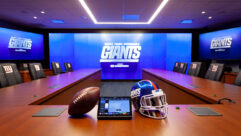
Installation Profile: Dawn of the Giants
Dec 1, 2007 12:00 PM,
By Jay Ankeney
Panasonic’s 103in. plasma displays grab attention at major facilities.

In the year since Panasonic introduced its 103in. plasma screen, the giant display has been making its way into both private homes and the public arena. As people get used to its large-as-life impact, the applications for the titan will only grow. Photos courtesy Peerless Industries.
Panasonic entered the record books about a year ago with its 103in. high-definition 1080p plasma display, officially known as the TH-103PF9UK. With a diagonal measurement of 103in., it was, at press time, the largest plasma display that has ever been made commercially available.
When Philo Farnsworth gave the world’s first public demonstration of what we would call “modern” television using his Image Dissector camera tube at the Franklin Institute in Philadelphia on Aug. 25, 1934, it was the half-toned image of his wife that stunned the audience. Today, with Panasonic’s 103in. TH-103PF9UK, it’s the currently unmatched size of the display that causes viewers to stare in wonder. After all, these $70,000 monoliths span more than 8.5ft. from corner to corner.
“Like all our professional monitors, we provide a wide range of customizable options for the TH-103PF9UK — except speakers,” says Karl DeManss, national product manager for pro plasma at Panasonic. “These are base monitors, and we never figured we could do audio well enough to complement the quality of the display.”
The TH-103PF9UK boasts a Super Cinema mode to provide “perfectly tuned color,” according to Panasonic. It also comes with a roster of high-end features, such as dual picture mode, digital zoom, and a built-in videowall image enlarger. But it is also a demanding giant, requiring 220V and consuming 1550W to produce its images.
The giant display also features Panasonic’s signature multifunction slots, which allow users to easily add to and update the display with different combinations of optional boards to meet practically any application. It comes standard with three interchangeable slots, which can accept a TY-FB9DD DVI board (compatible with UXGA input), a TY-42TM6A analog component board, an integrated D-Sub15 PC input, or an integrated D-Sub9 RS-232C interface.
The display’s impressive stats aside, though, how has it been received by the permanent installation market since its debut a year ago?
Since that time, about 30 percent of Panasonic’s sales of its giant display have been to private individuals, including the billionaire Mark Cuban. But DeManss predicts that, as people become accustomed to 16:9 images in their home, a major target for these visually enticing displays will be in the retail market.
“Panasonic believes there is a tremendous opportunity in the retail signage environment, and our 103in. plasma screen is the ideal delivery mechanism for communicating large, life-size, high-definition advertising,” DeManss says. “Many of the largest advertisers in the world have acknowledged that high-definition, full-motion-video advertisements capture and hold the attention of their target customers much better than static poster boards or light-box-style advertisements. The 103in. screen provides a similar size to the traditional 85in., 4:3 aspect ratio posters, but in a slightly wider 16:9 widescreen aspect ratio with 1080p clarity.”
In addition, because they were designed for high-definition display, the giant plasmas are well suited for repurposing video material created for home consumer broadcasts.
“This HD standard will provide an additional benefit to advertisers, allowing them to retask their TV video productions for additional promotion directly to audiences at retail or mall locations, taking maximum advantage of their video advertisement production costs,” DeManss says.
Of course, HD video projectors have long been able to throw large images onto a screen, but they also suffer degradation from ambient light and the distraction of shadows if someone walks in front of the projector’s lens. On top of that, with an expected life of 100,000 hours (measured until losing 50-percent brightness) — unlike a video projector — the TH-103PF9UK can be anticipated to provide maintenance-free operation for more than 21 years if kept on for 13 hours a day.

The installation at the Hyatt Regency hotel in Chicago was challenging; Peerless and Jesa Nationwide Services performed extensive testing to ensure they could safely suspend the weight of two TH-103PF9UKs two stories in the air using custom Peerless mounts.
HOSPITALITY ATTRACTION
Some of the most interesting installations of these TV titans have been in areas where their very presence draws crowds. One of the most spectacular places to see them is at the Hyatt Regency hotel in Chicago. Two TH-103PF9UKs hang in the glass atrium of the hotel’s lobby to entertain patrons in its elevated Big Bar, where guests are invited to sip martinis from 48oz. glasses while perched 30ft. above the entryway. This 158ft.-long, mezzanine-level stretch lounge is the longest freestanding bar in North America, according to the hotel.
The hotel had been entertaining Big Bar guests with a 10’×8′ projection screen visible from both the lounge area and the atrium floor, but light from the hotel’s glass ceiling relegated the 10,000-lumen projector to evening viewing at best. That’s why Tom Feilen, the Hyatt’s senior director of engineering, became interested in the potential of Panasonic’s 103in. plasmas.
“Instead of having just one projector in the atrium, last July, we decided to install two of the 103in. screens so our guests could watch opposing football games at the same time,” Feilen says. “But hanging screens that weigh 485lbs. each almost two stories above an active walkway area presented unique challenges. So we turned to Peerless Industries for a solution.”
Panasonic does provide custom mounting holes on the rear of the TH-103PF9UK, but those are intended for pedestal or wall mounts. “Peerless had already created standard wall mounts for the 103in. screens when we first installed them on the set of ABC Studios’ Monday Night Football in the network’s New York headquarters,” says Jason Kearns, product manager at Peerless Industries. “So we simply modified those mounts to create a surface from which we could hang the display. Then the trick was to suspend them up in the air.”
Peerless contracted with Chicago-based design and installation firm Jesa Nationwide Services for the onsite installation.
“We have had a lot of experience in the hospitality and house-of-worship arena in the Chicago area, and knew from the start this would be a major rigging challenge,” says Ken Johnson, Jesa business development manager. “The original idea was to hang the two screens back to back, angled so they could be seen from the both the lobby and the Big Bar. But in the end, they decided to orient them both toward the bar itself, hanging them on vertical posts about 30ft. apart.”
“We can’t tell you how much the whole project cost to suspend these screens, but you can get a good idea of what it would cost if we dropped them,” Johnson says. “Believe me, every care was taken to guarantee security. We obtained signoffs by structural engineers, and Hyatt obtained a solid insurance liability rider to cover the installation.”
Peerless also used its own equipment for weight-testing the vertical posts that would hold the 103in. plasmas in order to obtain Underwriters Laboratory certification. In the end, the company subjected the mounts to eight times the weight of the screens just to make sure.
“Panasonic also provides over 25 pages of instructions about moving, uncrating, and handling these screens,” Johnson says. “Finally, on March 4, 2007, we rigged the site, set up the hoists, and removed the projector. The next day, we ran the necessary 220V power to the plasmas through the interior of the supporting posts, hoisted up the screens, and suspended them from I-beams about 15ft. away from the edge of the Big Bar.”
Jesa also supervised calibration of the video screen displays under the guidance of Panasonic personnel, but in the end, it proved to be a simple process of using each screen’s own software to optimize its presentation. The screens had been displayed at the Consumer Electronics Show in Las Vegas earlier in the year. Now, they have become a destination event of themselves; guests come to the hotel atrium and its Big bar just to see them.
“Overall, the installation went extremely well,” Feilen says. “The 103in. screens have been received by our guests with enthusiasm, especially during major sporting events. When you look up at them from the floor, their size is not overwhelming. But when viewed from our Big Bar, they definitely present a display that is impossible to ignore.”
Installation Profile: Dawn of the Giants
Dec 1, 2007 12:00 PM,
By Jay Ankeney
Panasonic’s 103in. plasma displays grab attention at major facilities.
Calibrating four 103in. displays for Pechanga Resort and Casino’s poker room in Temecula, Calif., proved to be the easiest part of the installation; lifting the nearly 500lb. 103in. plasmas and mounting them securely on the walls was the hard part.
DISPLAY IN THE GAMING SPACE
Another venue in which to track the trail of these giants is the Pechanga Resort and Casino in Temecula, Calif. The resort now boasts five Panasonic 103in screens — four among the 16 NEC displays around the perimeter of the casino’s main poker room and the fifth adorning one of the resort’s restaurants.
“We originally had some 5000-lumen projectors in the poker room,” says Rod Luck, vice present of information technology at Pechanga Resort & Casino. “We wanted to use them to show sports presentations for the entertainment of our guests, but the high ambient light needed in the gaming table areas washed out their 8’×6′ screens. It was the brightness and contrast ratio of the TH-103PF9UK 103in. plasmas that induced us to turn to the Panasonic displays as a replacement. After all, they are pretty close to the size of the projection screens we had been trying to use before.”
About a year ago, executives from the Pechanga resort had seen these 103in. plasmas demonstrated at Disneyland in nearby Anaheim, Calif., and they walked away impressed. Installation in the poker room began last March, and the first challenge they ran into was simply finding a way to lift the monster screens into place.
“Eventually, we had to fabricate our own lifting jig since the top of the screen was going to be about 12ft. off the ground,” says Rick Gonzales, telecomm and audiovisual manager at Pechanga. “At almost 500lbs. apiece, you can’t just use two guys and a ladder. So we used some square boxed-steel tubes to make two scissor lifts working in unison that could elevate the screens safely.”
The Pechanga crew had already mounted four horizontal beams of Unistrut, approximately 6ft. across, directly to the wall studs in the poker room. Then, once they got the screens up in the air, each screen’s mounting brackets could be affixed to the Unistrut and its vertical load locked into place.
To give a video signal and AC power to the Panasonic displays, Gonzales’ team simply added a 20ft. extension to the wires and Cat-5 cables that had previously fed the projection systems. Calibrating the displays proved to be the easiest part of the installation.
“It was really plug-and-play,” Gonzales says. “The factory settings for every color parameter were perfect. We started receiving compliments about these screens even as we were hanging them. Once the word got out, people came into the poker room just to see them. The quality of these displays is a suitable reflection of the quality we want guests to experience whenever they visit the Pechanga Casino and Resort.”
With apologies to the Bard, modern audiences are starting to appreciate that “display’s the thing.” The success of Panasonic’s 103in. TH-103PF9UK in these types of facilities and several others has demonstrated that outsized plasma screens have a great deal of potential for the permanent-installation industry. No doubt, other screen manufacturers are taking notice.
Jay Ankeneyis an industry consultant and former TV network engineer living in the Los Angeles area.









